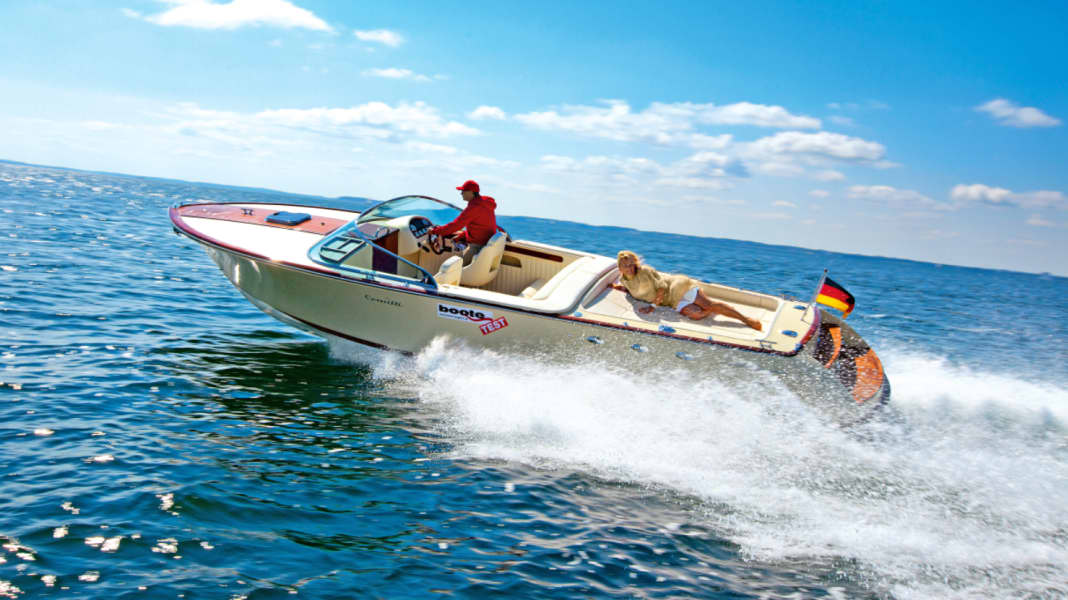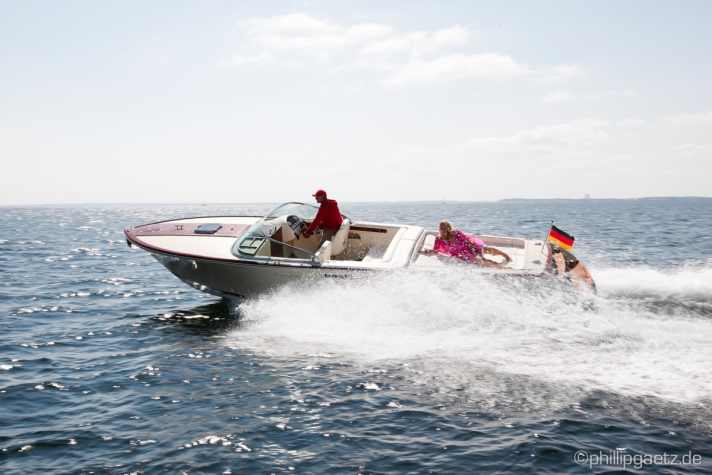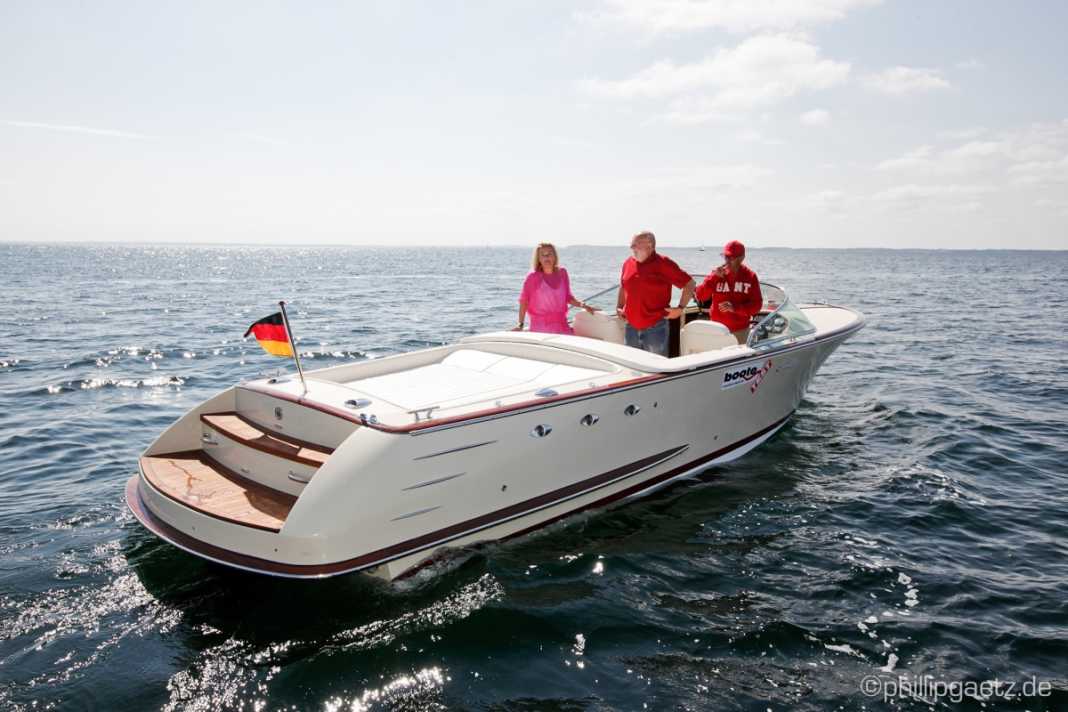

That's a Riva made of plastic - isn't it? Anyone who, like Comitti, is inspired by the classics from Sarnico should not be surprised. Even if the Comitti makers are occasionally annoyed by the hundreds of questions about their origins, it is also a little flattering to the ego to be constantly "confused" with the boat builders from Lake Iseo.

Elegant shapes, a flat foredeck, a windscreen framed in stainless steel, a deep cockpit and a comfortable sun lounger - everything as it used to be. Think again! Because everything has to be affordable somewhere, Comitti builds its beauties out of fibreglass-reinforced plastic, with the exception of the Wooden Line (6.50 and 7.50 m). Mahogany and teak are only used in the Venezia 28 Sport as furniture, chic applications and on the bathing platform and cockpit floor.






No matter what material the boat builders use, the workmanship is always excellent. The fact that Como has arrived in the 21st century is evident in the design of the underwater hull and the drive. A flat bottom and wave system is a thing of the past. If you want to be fast, comfortable and economical in rough water, you need a hull with a deep V-frame and spray rails, powerful, electronically controlled engines and Z-drives with twin propellers. The Venezia 28 Sport has all of this on offer.
Even if the not exactly long list of standard equipment might suggest otherwise, when it comes to equipment, the world's largest car manufacturer is taken as a role model: "Nothing is impossible." The crux of the matter is that the Italian boat builders pay well for their flexibility. However, the Venezia 28, which can be easily towed with a powerful tug - 3.5 tonnes towing capacity is a must - proves to be a first-class classic in the test, which not only water skiers and sun worshippers will enjoy. Once it gets late, the slip cabin offers sufficient comfort for an overnight stay.
Driving and manoeuvring
Those who create need power. This also applies to the Venezia 28's engines, which include five large-volume V-8 petrol engines (320 to 425 hp) and two turbodiesels (270 and 300 hp) with six cylinders in series. The top performer and our test engine is MerCruiser's 496 MPI HO. High-Output (HO) is 425 hp, which is converted into thrust by the stainless steel twin propellers of the Bravo-Three drive. The "high output" makes the test Venetia 47.8 knots fast at full load. Respect!
The 4600 rpm achieved is an indication that the 28 mm props fitted are one size too big. Less pitch will not necessarily improve the speed, but it will improve the already impressive acceleration. Provided the trim position of the Z-drive is correct. Too much of it (drive raised too far) will cause the nose to rise sharply, turning the transition to gliding into a blind flight. Correctly trimmed (drive down), you can make rapid progress with vision and without propeller ventilation through tight bends and circles.
The boat really lies on its side, but shows no tendency to hook or rock even at 40 knots. The feeling of safety is not only enhanced in these situations by the super-smooth yet direct power steering. The tightly upholstered seats for the driver and co-driver cannot keep up due to the lack of lateral support.
The Venezia masters the "roundabout" in the harbour and displacement sailing with flying colours. In other words, it turns in the tightest of spaces, can be reversed directly even when travelling in reverse and runs stubbornly straight ahead even at low speeds without a large stern wave. MerCruiser's electric gearstick and the reclining seat, which allows the driver to stand comfortably when manoeuvring, also deserve praise for their comfort and safety.
You are only in rough water, if at all, on upwind courses, where spray water makes the slightly tinted safety glass of the sturdy windscreen and the lack of windscreen wipers opaque. Swell, at least at three Beaufort on the Baltic Sea, is not a problem. The heavily chined-up hull remains stable at all times and starts smoothly even at 40 knots.
The skipper can see where he is going, how the engine is doing and whether there is enough fuel to get to the next petrol station on the dashboard, which is equipped with round instruments and a touchscreen that also functions as a switch. However, he should know in advance that in the full load range there are just 86 nm between starting and refuelling. Of course, power comes from fuel. Of the latter, the
8.1-litre V-8 consumes 1.77 l/sm of the latter when cruising economically at just under 30 knots. If 15% of the tank contents are taken into account as a reserve, the skipper can plan on a range of 134 nm, which puts the Venezia with the large eight-cylinder below the specified class standard (150 nm) of the BOOTE testers.
Engine, tank, electrics
The fact that the V-8 nevertheless feels comfortable at its workplace is due to the good "working atmosphere". As the measurement results show, the engine compartment is well ventilated and sufficiently soundproofed with self-extinguishing foam. In addition, there is sufficient space for servicing and solid foundations, and hoses, cables and Bowden cables are neatly routed.
Plus points of the tank installation: the stainless steel finish, shut-off valve with remote control, inspection hatch, potential equalisation, a filter with integrated water separator and hose clamps in a double pack. The motto "Two last longer" also applies to the two 100 Ah batteries. The starter and on-board power circuits are separated by diodes and switched on and off via an easily accessible main switch.
Security
In addition to the driving characteristics, the cockpit with non-slip floor, bathing platform with ladder, escape hatch, engine compartment blower, hand fire extinguisher and the extinguishing system in the engine compartment fulfil the requirements of the testers. Criticism was levelled at the bilge pump, which does not offer sufficient protection without a manual bilge pump, the smooth foredeck, which is difficult to access, the lack of handholds (to go into series production immediately) and the position lanterns without German approval.
Cockpit, living, equipment
The cockpit, which is neatly lined with artificial leather, offers space for the driving position, two individual seats and a well-padded rear bench seat, the console of which is used as a large storage space. Sun worshippers will find their place above the engine compartment. Those who prefer to lie in the shade, on the other hand, will discover a V-berth without ventilation as well as a small, partitioned cupboard, two shelves and the same imitation leather on the walls as in the cockpit in the slip cabin under the foredeck.
Do you want more than five solid mooring cleats, six fender eyelets, a robust stainless steel rubbing strake, a plug-in mast and a bimini top? Under the heading "optional extras", there are nice things like a convertible top, harbour tarpaulin, anchor and winch, refrigerator, an electric toilet and a stern shower. As you will remember, nothing is impossible.
The shipyard says...
The trailerable Venezia 28 Sport is a sporty runabout with timeless elegance paired with modern technology. Completely handcrafted with masterly attention to detail, it can be customised to meet individual equipment requirements far removed from the standard options. Safe handling characteristics and excellent rough water suitability guarantee dry sailing even when used close to the coast.
BOOTE says...
When it comes to trailering, elegance and sailing characteristics, we agree with the shipyard, even if rough water cruising is not always dry. In any case, the Venezia 28 is a first-class day cruiser
with a sporty character. The question is whether retro enthusiasts have to accept a smooth, hard-to-reach foredeck. The fact is, if you want a complete equipment package, you have to pay extra.
Data sheet: Comitti Venezia 28 Sport
Shipyard: Comitti SpA
Type designation: Comitti Venezia 28 Sport
CE category: C - Coastal waters
Material of hull and deck: Plastic
Length: 8,70 m
Width: 2,49 m
Displacement: 2,45 t
Price: 181.730,00 €

